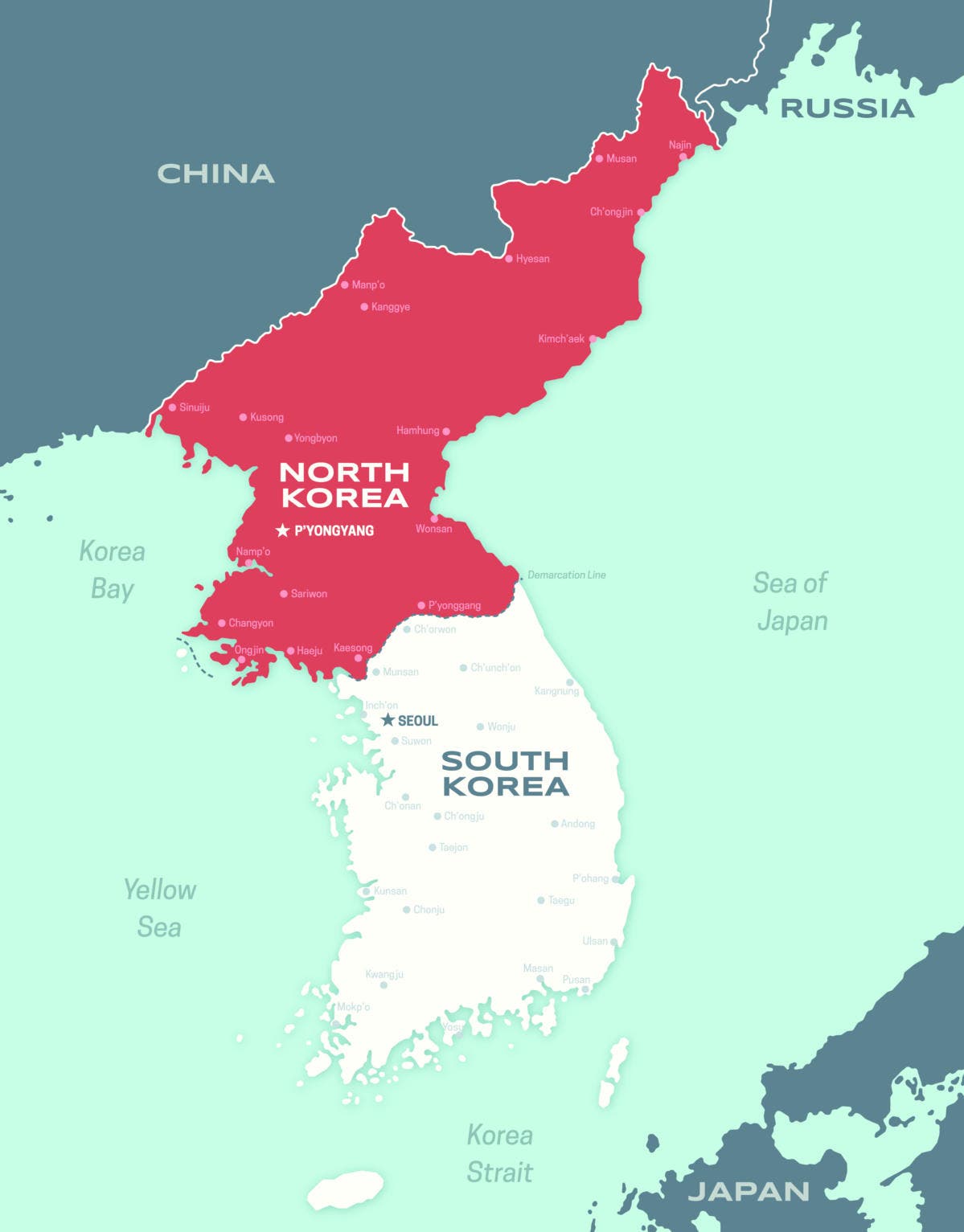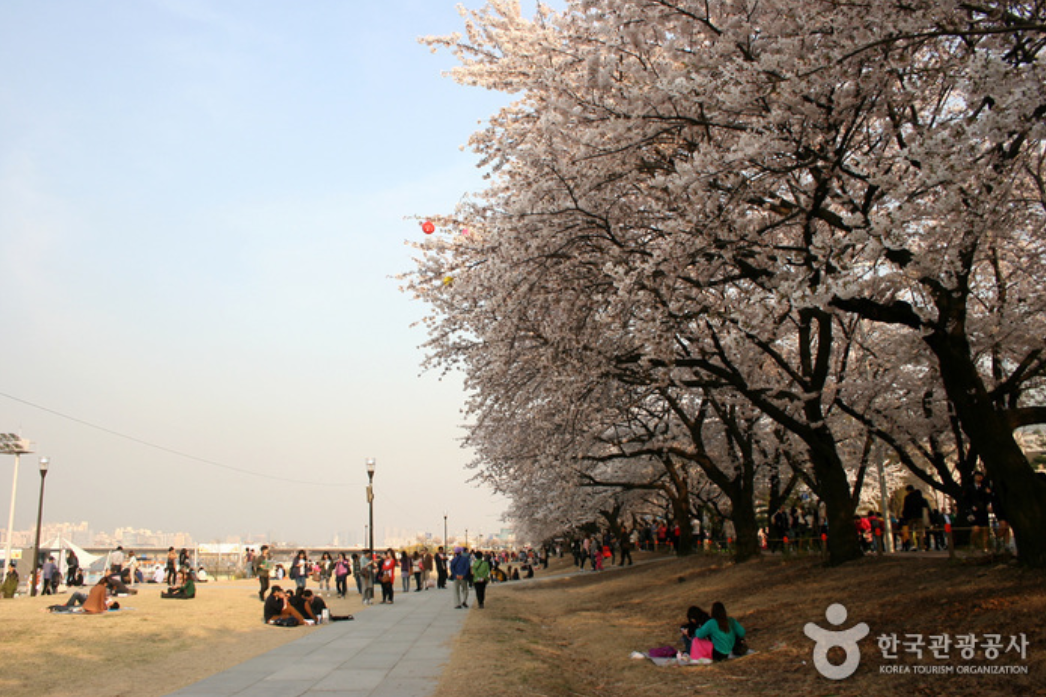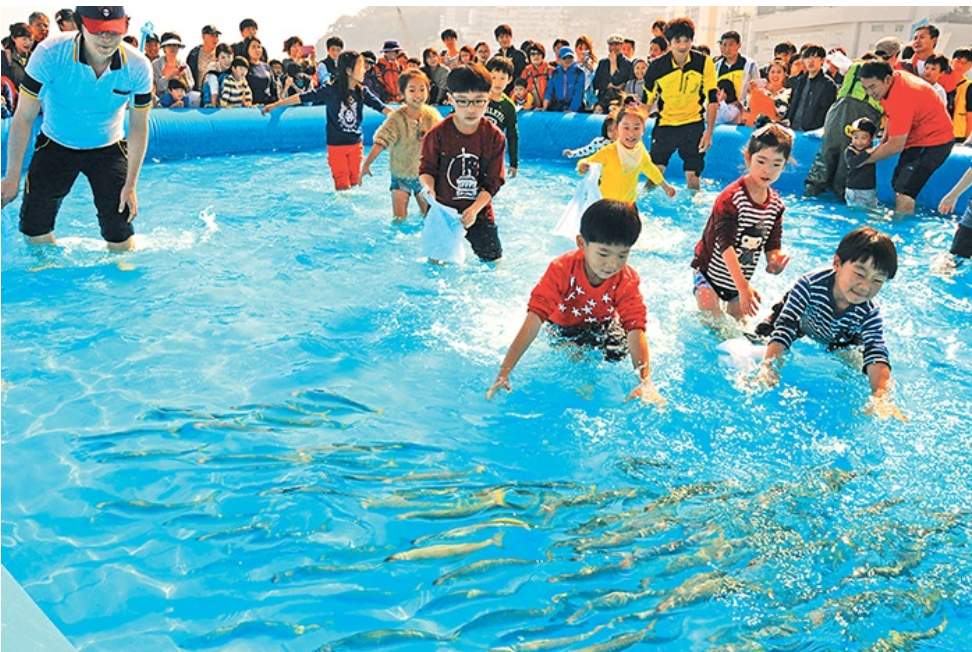Where is Korean spoken?
- There are 76 million native Korean speakers, the vast majority of whom reside in North and South Korea (map below). Both North Korea, with 24 million speakers, and South Korea, with 48 million speakers, list Korean as their official language. Outside these countries, a significant number of native Korean speakers live in China, the United States, and Japan.

Map of North Korea and South Korea in East Asia (from Pruitt, 2021).
Climate education in South Korea
- One of South Korea’s main concerns related to climate change is a potential alteration of the monsoon cycle. The increase in monsoon intensity caused by a warming climate could increase flooding in some regions and droughts in other parts of the country.
- Surveys in South Korea indicate that overall, citizens have a high awareness of recent climate change. More than 85% of those surveyed, who also believe they know the causes of climate change, consider it a serious problem.
- In 2008, then South Korean President, Lee Myung-bak (이명박) announced a “low carbon, green growth” principle as a direction for the future. The current administration aims to cut emissions by 40% below 2018 levels before 2030, and plans to be carbon-neutral by 2050.
- Implementing environmental education has been in the works of South Korea since the 1980s. Most students receive bits of climate change education through their mandatory social science and natural sciences courses. The National Curriculum Framework helps create opportunities for students to learn more throughout their pre-primary, primary, and secondary education journey.
- In primary school, students learn about weather and climate in general. During secondary school, students are offered an optional course in Environmental Education. Teachers are given autonomy on how to navigate the course. Usually, students learn to respond to environmental issues that arise in their daily lives, while also gaining an overall understanding of environmental systems.
- Regardless of whether or not students enroll in the optional course on Environmental Education, they will learn about environmental issues (greenhouse effect, global warming, etc.), sustainable development, and more in their required Science and Social Science courses.
- In 2020, the government also put an emphasis on future plans that will use activity-based learning instead of lecture-based learning to increase the effectiveness of climate change education. The 3rd Masterplan of Environmental Education, also created in 2020, aims to provide more climate education training for primary and secondary educators
- You can learn more about climate education in Korea through the Monitoring and Evaluating Climate Communication and Education (MECCE) Project here.
Climate and Culture in South Korea
- South Korea is the 3rd most densely populated country in the world. It has 4 distinct seasons: the spring and fall seasons are rather mild, winters are cold and dry, -5 ℃ to 2 ℃ (23°F to 36°C), and summers are humid and warm, around 25 ℃ (77°F). From 1912 to 2010 Korean temperatures increased by about 1.8°C (3.2°F) and it is projected that temperatures in Korea will continue to rise by an additional 2.9°C (5.2°F) by 2100.
- The yearly precipitation in the mainland of South Korea ranges from 88.9 to 152.4 centimeters (35 to 60 inches), depending on the region. Most of this precipitation takes place during the summer monsoon season.
- Every spring, yellow dust also known as Asian dust blows over South Korea from the deserts of Northern China and Mongolia.
- This dust is continuously increasing in volume due to the desertification, industrialization, and warming of China. It contains both fine and ultrafine particles. Fine particles can be inhaled and lodge in the lungs, while ultrafine particles can go through alveoli (tiny air sacs of the lungs) and into the bloodstream.
- The dust picks up industrial chemicals and metals such as cadmium, mercury, nitric acid, volatile organic compounds, sulfuric acid etc. When people breathe in this dust it leaches pollutants and carcinogens into their bloodstream and clogs up their lungs. This can lead to cancer, vascular disease, coronary heart disease, birth defects and more. People with pre-existing conditions are the most at risk.
- South Korea has a forecasting system that alerts people to the levels of yellow dust in the air. Every spring South Koreans wear masks when outside and on days when the forecasts are high avoid leaving their houses at all.
- South Korea has seasonal festivals, many of which are linked to the blooming of certain plants.
- The mid-April Yeouido Spring Flower Festival in Seoul (서울) (pictured below) is associated with blooms of azaleas, forsythia, royal azaleas, and cherry blossoms.
- There is also an annual cherry blossom festival during the end of March and beginning of April in Jungwon Rotary and downtown Jinhae (진해) in the city of Busan (부산광역시).

- Image of people enjoying the blooms at the annual Yeouido Spring Flower Festival (from Visit Korea 2021).
- Fish is an incredibly important part of South Korean food and culture. South Korea consumes the most seafood per person per year of any other country in the world.
- There are many festivals across South Korea focusing on fish and seafood. Some examples include:
- The Busan Mackerel Festival (pictured below) in autumn is a celebration of one of the area’s most important fish. Busan Cooperative Fish Market sells more than 90% of the nation’s mackerel. The festival includes many mackerel themed games and activities, and booths selling mackerel prepared in a variety of ways.
- The Annual Ice Fishing Festival in Hwacheon (화천군), Gangwon Province (강원도) is a very popular event attracting thousands of people that celebrates the ancient tradition of ice fishing for Mountain Trout. Visitors dig holes in the ice and try to catch some trout, which they then cook at the festival kitchen. There are also lots of winter themed activities such as sledding and ice sculpting.
- Climate change alters and damages oceanic ecosystems faster than species can adapt to. Because of this, and because of overfishing due to global population growth, the global fish stocks have been in decline for a long time. As the seafood that South Koreans love to eat such as squid, salmon, sod, mackerel, etc. disappear from the waters adjacent to the Korean peninsula, Korean fishers are forced to move farther and farther from the coast to catch the fish their livelihoods depend on.
- As the global fish stocks decline, Korean consumers are becoming more and more interested in sustainable seafood. Brands like Homeplus, Dongwon Industries, Wando Eco-Friendly Seafood Cooperative, and even McDonalds have started selling their own lines of sustainably sourced seafood.
- There are many festivals across South Korea focusing on fish and seafood. Some examples include:

- Image of kids catching mackerel at the Busan Mackerel Festival (from Enjoy Busan).
- In the snowy, mountainous regions of Korea, winter sports like skiing, snowboarding, sledding, and ice fishing are a large part of the culture and economy.
- In 2018 the 23rd Winter Olympics were held in PyeongChang(평창), South Korea. High-speed rail lines were built between Seoul and PyeongChang, and a total of 2933 athletes competed in 15 sports: Alpine Skiing, Biathlon, Bobsleigh, Cross Country Skiing, Curling, Figure Skating, Freestyle Skiing, Ice Hockey, Luge, Nordic Combined, Short Track, Skeleton, Ski Jumping, Snowboard, and Speed Skating.
- 10 of the 15 sports featured in the 2018 Winter Olympics are performed outside and require snow. As global temperatures increase there is less snow for outdoor winter sports to rely on. One solution to the lack of snow on ski slopes is the production of artificial snow. But producing artificial snow comes with its own environmental risks and costs. The process of artificially producing snow uses up water that could be used for drinking, and energy that is most likely fossil fuel derived. It also takes longer to melt than naturally produced snow, which can have a negative impact on the water table.
Language practice
Try to translate this excerpt (from Naver) using the word bank and grammar points below:
사전적으로 기후는 ‘일정한 지역에서 장기간에 걸쳐 나타나는 대기현상의 평균적인 상태. 날씨가 시시각각 변화하는 순간적인 대기현상이라면, 기후는 장기간의 대기현상을 종합한 것이다.’라고 정의된다.
Word Bank
To make the translation easier, the Korean terms and phrases are listed in the form they appear in the excerpt.
| Korean Term/Phrase | English Definition/Meaning | Korean Term/Phrase | English Definition/Meaning |
| 대기현상
(dae-gi-hyeon-sang) |
Atmospheric | 순간적인
(sun-gan-jeog-in) |
instantaneous |
| 평균적인
(pyeong-gyun-jeog-in) |
Average | 것이다
(geo-shi-da) |
Is |
| 변화하는
(byeon-hwa-ha-neun) |
Changing | 라고 정의된다
(ra-go jeong-eui-dwe-da) |
Is defined as |
| 기후
(gi-hu) |
Climate | 장기간의
(jang-gi-gan-eui |
Long-term |
| 상태
(sang-tae) |
Condition | 시시각각
(shi-shi-gan-gan) |
Moment to moment |
| 사전적
(sa-jeon-jeog) |
Dictionary | 장기간에 걸쳐
(jang-gi-gan-eh geol-chyeo) |
Over a long period of time |
| 이라면
(i-ra-myeon) |
If this is… | 나타나는
(na-ta-na-neun) |
Phenomenon |
| 일정한 지역에서
(il-jeong-han ji-yeog-eh-seo) |
In a certain area | 종합한
(jong-hab-han) |
Synthesis |
| 날씨가
(nal-shi-ga) |
Weather |
Grammar Points
| Grammar Point | Example Sentences |
| 에 means at. It indicates location. It goes on the end of the location noun. | 나는 집에있어요.
I am at home. My location is home |
| 는 is the subject particle. It indicates the subject of the clause. It goes at the end of the subject. | 저는 고양이를 좋아해요.
I like cats. I am the subject. |
| Sentence structure: In Korean sentences, the verb is always the last word in a sentence. The subject is usually at the beginning of the sentence. | So if you wanted to say “I(저) like(좋아하다) cats(고양이)”,
You would not say “저는 좋아하다 고양이를” You would restructure it to, “저는 고양이를 좋아해요.” |
Translation key:
Do not read this until you have completed the translation challenge!
In the dictionary, climate is defined as “the average state of atmospheric phenomena that occurs over a long period of time in a certain area. If weather is an instantaneous atmospheric phenomenon that changes from moment to moment, then climate is a synthesis of long-term atmospheric phenomena.
References and additional resources:
- “Asian Dust in South Korea”, University of Colorado Boulder, https://storm.colorado.edu/~toohey/asiandust.pdf
- Ban K, “Climate”, Naver, July 2016, https://terms.naver.com/entry.naver?docId=3580715&cid=58947&categoryId=58981
- Costa H., Sprout E., Teng S., McDaniel M., Hunt J., Boudreau D., Ramroop T., Rutledge K., and Hall H., “Monsoon”, National Geographic, September 15 2022, Monsoon (nationalgeographic.org)
- Choi H., Kim J.J., Kang C., “South Korean Perception on Climate Change”, The Asian Institute for Policy Studies, February 18, 2020, https://en.asaninst.org/contents/south-korean-perception-on-climate-change/
- CNN Editorial Research, “2018 PyeongChang Winter Olympics Fast Facts”, CNN, 2021, https://www.cnn.com/2017/12/08/world/2018-pyeongchang-winter-olympics-fast-facts/index.html
- Dingle A., “Open for Discussion: Artificial Snow: A Slippery Slope”, American Chemical Society, 2019, https://www.acs.org/education/resources/highschool/chemmatters/past-issues/2018-2019/december-2018/artificial-snow-a-slippery-slope.html
- Enjoy Busan, “Busan’s History Alive and Well in Festivals”, Dynamic Busan, https://www.busan.go.kr/dynamic/enjoy-busan/view?srchCl=Enjoy+Busan&bbsNo=10&dataNo=63325
- Feffer, J., “The Climate Crisis and Korea”, Institute for Policy Studies, August 17, 2021, https://ips-dc.org/the-climate-crisis-and-korea/
- “Hwacheon Sancheoneo Ice Festival Tour from Seoul”, Klook Travel, https://www.klook.com/en-US/activity/2088-hwacheon-sancheoneo-trout-ice-festival-gangwon-do/
- Kang D, and Kim J, “Fine, Ultrafine, and Yellow Dust: Emerging Health Problems in Korea”, Journal of Korean Medical Science 29(5): 621–622, April 25, 2014, https://www.ncbi.nlm.nih.gov/pmc/articles/PMC4024940/
- Lew I.Y., Yu W., Hahn B., “South Korea”, Encyclopedia Britanicca, last updated February 23, 2023, South Korea | History, Map, Flag, Capital, Population, President, & Facts | Britannica
- Martin, S. “Korean language.” Encyclopedia Britannica. April 2023. https://www.britannica.com/topic/Korean-language.
- O’Leary R., Jarman K., Herz K., “Top Festivals in South Korea”, Jacada Travel, https://www.jacadatravel.com/asia/south-korea/travel-guides/top-festivals-in-south-korea/
- Pruitt, S. “Why Are North and South Korea Divided?” History.com. June 2021. https://www.history.com/news/north-south-korea-divided-reasons-facts.
- “PyeongChang 2018 Winter Olympics”, Olympics, 2018, https://olympics.com/en/olympic-games/pyeongchang-2018
- Sung J., “Climate Change Education and Education for Sustainable Development in the Republic of Korea: A Status Report”, Journal of Education for Sustainable Development, Volume 9, Issue 1, https://doi.org/10.1177/0973408215569116
- “South Korea Aims to Cut Carbon Emissions by 40% in 2030”, AP News, October 18,2021, https://apnews.com/article/climate-change-business-europe-scotland-moon-jae-in-847cba4f6c6be815489f722c2b5a256a
- “South Korea’s Insatiable Appetite for Sustainable Seafood”, Marine Stewardship Council, June 23, 2021, https://www.msc.org/media-centre/news-opinion/news/2021/06/23/south-korea-s-insatiable-appetite-for-sustainable-seafood
- The Monitoring and Evaluating Climate Communication and Education Project, “CCE Country Profile: Republic of Korea”, https://mecce.ca/country_profiles/cce-country-profile-republic-of-korea/
- The Republic of Korea, “Fourth National Communication of the Republic of Korea”, November 2019, 4차 국가보고서1125-영문판.indd (unfccc.int)
- Visit Korea, “Yeongdeungpo Yeouido Spring Flower Festival”, 2021, https://english.visitkorea.or.kr/enu/ATR/SI_EN_3_2_1.jsp?cid=700464
- Wharton D., “How climate change is threatening the future of the Winter Olympics”, Los Angeles Times, February 2022, https://www.latimes.com/sports/olympics/story/2022-02-03/climate-change-global-warming-impact-winter-olympic-games
